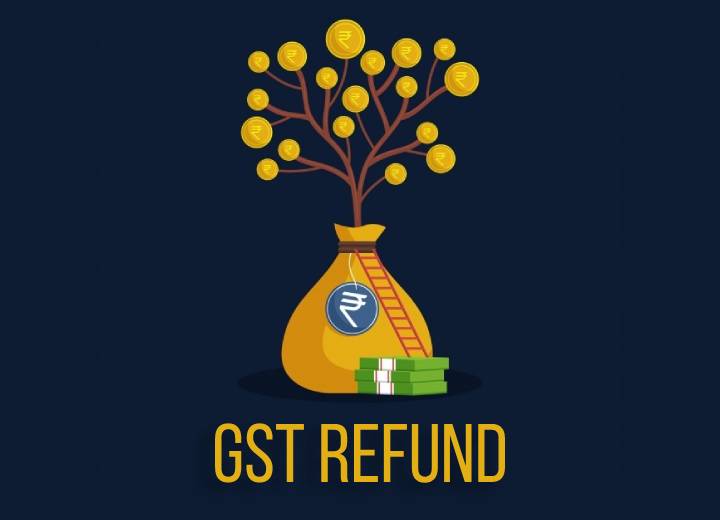The infusion of GST offered an on-track taxation system by offering a foremost mechanism to monitor and record ongoing trades. The best part about the GST system is that you can file a GST refund of the paid tax. The refund under GST has to be filed every month after mentioning the overall monthly sales through GSTR-1. You just need to follow up on the GST refund procedure by filling the GSTR-3B form. Not familiar with the procedures and basics? Fret not as we have encapsulated every required detail in this well-curated guide. Just keep scrolling and wave off every query you do have about the GST refund.
What is a GST Refund?
GST refund is an exceptional process that allows the registered taxpayers to claim the additional amount that they have paid above the liable GST. Taxpayers can easily claim this amount by submitting a refund application together with the vital details. All this information has to be submitted on the official GST portal.
The manufacturers and the exporters might have to face adverse effects of cash flow along with the working capital requirements due to delayed GST refunds. Considering such situations, a GST refund was implemented to ensure no such delays occur and the taxpayers don’t have to face such case scenarios. Infusion of GST ensures that the refund process is quick and seamless. With an effective refund procedure, taxpayers can access uninterrupted tax administration.
The GST regime comprises refund-related provisions, which further aim to streamline and standardize overall procedures carried out under GST. Therefore, through GST a standardized mechanism has been introduced to offer prompt claims to access refunds. Through the online GST refund procedure, claims can be easily filed with utmost ease in minimal time.
When Can the Refund be Claimed?
The presence of efficient tax administration is crucial to put forward an appropriate refund mechanism. The claiming mechanism must be smooth and take minimal time to release funds as the trade entirely orients around the release of blocked payments or finances. The release is important to ensure business expansion and to fulfill the capital requirements of the venture.
Following Situations Lead to the GST Refund Claims:
- Exports of goods/services
- Deemed trade (exports)
- Tax refund in the case of a purchase made by the embassies
- Supply of commodities to developers and other units within the special economic zones
- Pre-deposit refund
- A refund that arises from an order or judgment passed by the Appellate Tribunal, or any Appellate Authority or by the court of law
- Completion of provisional assessment
- Release Of excessive payment due to system or software error
- Refund in case the refund vouchers are issued to pay the liable taxes against the supply of commodities/ goods or services
- Refunds for the tourists on the GST paid on the purchase specific items that they carry out at the time of departure
- Refund of SGST as well as CGST that is paid on inter-state trade.
GST Refund Procedure:
The GST refund procedure is quite easy as you just need to compute the values together with the liable interest and late fee amount. Usually, the Input Tax Credit is taken off from the Outward Tax Liability for calculating the overall amount of GST payment that has to be released. Next to this the TDS/TCS is deducted from the overall GST amount to compute the net payable refund figure. Additionally, this figure comprises the interest amount together with the applicable late fees too.
However, an individual cannot claim ITC on the interest amount or late fees as both of these have to be paid in cash. The GST refund procedure might vary a bit depending on the type of dealer i.,e. Regular dealer or composition dealer.
Regular Dealer:
A regular dealer is supposed to pay the GST on all outward supplies that have been made and can file a GST refund for the same along with the ITC or Income Tax Credit on the purchase of goods made by him. The key difference between these two is the overall amount of GST that is paid by the dealer.
Composition Dealer:
The payment of GST is a cakewalk specifically for the composition dealer. A dealer registered under the GST composition scheme has to pay a static percentage or fixed amount of the GST that is applicable on the final outward supply that has been made in the entire business course. The amount of GST paid is determined by the type of business the composition dealer is running.
- Total GST Paid is equal to O.1 percentage in case of a Goods manufacturer or trader.
- 5% of the outward liability is paid as GST if you are running a restaurant that does not serve alcohol
Note: If you are a Service Provider you are not eligible to avail of the composition scheme.
Steps to Claim Refund Under GST:
To claim a Refund under GST you need to follow the below-depicted steps:
- First, you need to visit the official GSTN portal. Then fill and submit the application form meant to claim a GST refund.
- After filling the GST refund form you will receive a mail or message on the listed number which will consist of the acknowledgment number. You will receive this acknowledgment number after submitting the claim application.
- Next to this the cash together with the return ledger is adjusted and the reduction of the “carry-forward input tax credit” takes place.
- The application that you previously submitted is scrutinized together with the submitted documents. This process is carried out by the authorities within a time frame of 30 days after the submission of the claim application.
- Next to this, the authorities put forward “Unjust enrichment”. If the submitted application fails to qualify, the refund amount is transferred to the CWF or Consumer Welfare Fund.
- If the filed refund is more than the predetermined refund amount, then the officials carry out a pre-audit process before actually sanctioning the refund amount.
- The refund amount is credited electronically to the applicant’s account via NEFT, RTGS, or ECS.
Note: Individuals can file refund applications at the end of every quarter i.e. once every four months. If the claimed amount is below INR 1000, the individual will not be able to receive the refund.
Time Limit to Claim GST Refund:
There is a time limit within which an individual has to claim a GST refund. Additionally, the GSTR 3 Form is used to file the claim. It has to be filled and submitted on the 20th of next month.
However, the time limit to file the claim is two years from the date when the payment was made. Refer to the depicted table to get familiar with the payment date in different case scenarios:
|
Reason to claim GST Refund |
Relevant Date |
|
Excess payment of Goods and Services Tax |
Date of Payment |
|
Export / Deemed export of commodities and services |
Date of dispatch or date of loading or date on which the frontier was passed |
|
ITC accumulates that the tax is exempted or rates the tax as nil |
On the last day of the FY to which the claimed credit belongs too |
| Finalization of the Provisional assessment |
Date of adjusted tax |
How to Claim a GST Refund?
The individual has to submit the refund application electronically by filling Form RFD 01. This form has to be submitted within the time frame of 2 yrs of the respective date. The applicant is supposed to provide the refund application that is certified by a Cost Accountant / Chartered Accountant specifically if the overall amount is more than INR 2 lakhs.
The GST refund application then undergoes inspection and audit by the officials to determine if the mentioned amount is appropriate or not. After validating, the officials approve the application, the taxpayer receives the refund amount in the registered account.
Documents Required to File Refund under GST:
Applicants who file a GST refund are supposed to submit a specific set of documents. The authenticity of these documents helps to determine the overall amount of the refund by the officials. To file the refund under GST you have to submit primary requisite documents such as relevant invoices.
If the refund has to be made in case of export of services, in the absence of a statement of invoices, then the dealer is supposed to submit bank realization certificates that verify the receipt of payment.
If the supplier of goods and services is making the claim from the Special Economic Zones (SEZ) unit, then the authorized officials will be liable to make an endorsement that verifies the receiving of commodities or services within the SEZ. The same will be submitted to GST officials together with other documents including the declaration.
Latest Update on GST Refund:
As per the latest GST Refund update made on 1st May 2021:
The time frame of passing orders in terms of refund rejection or approval of refund claims (fully or partly) i.e. from 15th April 2021 to 30th May 2021 has been extended.
The extended time frame to file GST refund is:
- 15 days of answering the received notice OR
- 31st May 2021
YOU MAY ALSO LIKE
Frequently Asked Questions (FAQ’s)
How do I get my GST Refund?
The taxpayers are eligible to claim a refund of the tax paid, interest amount, penalty if any, fees together with any other paid amount. This can be availed by filling an electronic application form GST RFD-01 by visiting the official GSTN portal or by in-person visiting and submitting the application at the GST Facilitation Centre.
Can we claim a GST refund?
Yes, we can claim a GST refund as per Section 54(3)mentioned within the CGST Act, 2017. It states that the registered person can file a claim for a refund of the paid Input Tax Credit by the end of the tax period. A tax period can be defined as a period of time for which the refund is liable to be furnished. Thus, any taxpayer can claim a refund of the unutilized ITC on a monthly basis.
When can a GST Refund be claimed?
Within two years of the relevant date, the taxpayer is liable to claim the GST refund.
What Amount can you avail of as a GST Refund?
As per the GST updates made in 2020 ( applicable on the claims of July 2021 to June 2022), a taxpayer can get up to $456 if single, $598 if married or do have a common-law partner, and $157 for the child who is below 19.
How to calculate GST from a Total?
The following formula is used to compute the GST from a total:
Add GST
GST Amount is equal to (Original Cost * GST percentage)/100.
Net Price is equal to Original Cost + GST Amount.
Remove GST
GST Amount is equal to Original Cost – [Original Cost * {100/(100+GST percent)}]
Net Price is equal to Original Cost – GST Amount.




































